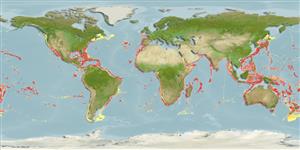Common names from other countries
>
Scombriformes (Mackerels) >
Gempylidae (Snake mackerels)
Etymology: Lepidocybium: Greek, lepis = scale + Greek, kybion, -ou = tunna (Ref. 45335).
Environment: milieu / Klimaatzone / Diepte / distribution range
Ecologie
marien benthopelagisch; oceanodroom (Ref. 51243); diepte 200 - 1100 m (Ref. 44037). Deep-water; 50°N - 56°S, 180°W - 180°E (Ref. 6181)
Tropical and temperate seas of the World, but probably not occurring in the northern Indian Ocean. Northwest Atlantic: Canada (Ref. 5951). Eastern Atlantic: known from 13°N off Guinea to Lobutu, Angola (Ref. 10816).
Grootte / Gewicht / Leeftijd
Maturiteit: Lm ? range ? - ? cm
Max length : 200 cm SL mannelijk / geslacht onbekend; (Ref. 6181); common length : 150 cm SL mannelijk / geslacht onbekend; (Ref. 6181); max. gepubliceerd gewicht: 45.0 kg (Ref. 3403)
Dorsale stekels (totaal) : 8 - 9; Dorsale zachte stralen (totaal) : 16 - 18; Anale stekels: 1 - 2; Anale zachte stralen: 12 - 14; Wervels: 31. Body almost uniformly dark brown, becoming almost black with age. Pelvic fins well developed, with I spine and 5 soft rays (Ref. 9784). Prominent lateral keel on caudal peduncle, flanked by smaller accessory keels above and below (Ref. 26938).
Body shape (shape guide): fusiform / normal; Cross section: oval.
Occurs mainly over the continental slope, down to 200 m and more (Ref. 6181). Migrates upward at night (Ref. 6181). Feeds on squid, crustaceans and a wide variety of fishes (Ref. 6181). Flesh oily and may have purgative properties (Ref. 9784). Sometimes caught by tuna long-liners (Ref. 26938). Marketed frozen and as fish cakes in Japan (Ref. 9302).
Levenscyclus en paargedrag
Maturiteit | Voortplanting | Paaien | Eieren | Fecunditeit | Larven
Nakamura, I. and N.V. Parin, 1993. FAO Species Catalogue. Vol. 15. Snake mackerels and cutlassfishes of the world (families Gempylidae and Trichiuridae). An annotated and illustrated catalogue of the snake mackerels, snoeks, escolars, gemfishes, sackfishes, domine, oilfish, cutlassfishes,. scabbardfishes, hairtails, and frostfishes known to date. FAO Fish. Synop. 125(15):136 p. (Ref. 6181)
Status op de Rode Lijst van het IUCN (Ref. 130435: Version 2025-1)
Gevaar voor de mens
Harmless
Gebruik door de mens
Visserij: van minder commercieel belang; sportvis: ja
Tools
Speciale rapporten
Download XML
Internetbronnen
Estimates based on models
Preferred temperature (Ref.
123201): 7 - 14.4, mean 9.9 °C (based on 642 cells).
Fylogenetische diversiteitsindex (Ref.
82804): PD
50 = 1.0000 [Uniqueness, from 0.5 = low to 2.0 = high].
Bayesian length-weight: a=0.01202 (0.00608 - 0.02377), b=2.98 (2.80 - 3.16), in cm total length, based on LWR estimates for this species & (Sub)family-body (Ref.
93245).
Trofisch niveau (Ref.
69278): 4.3 ±0.67 se; based on food items.
Weerstandsvermogen (Ref.
120179): laag, minimale populatieverdubbelingstijd 4,5-14 jaar (Assuming tm=4-5).
Fishing Vulnerability (Ref.
59153): Very high vulnerability (90 of 100).
🛈
Climate Vulnerability (Ref.
125649): Moderate vulnerability (39 of 100).
🛈
Nutrients (Ref.
124155): Calcium = 7.33 [3.81, 15.92] mg/100g; Iron = 0.279 [0.128, 0.578] mg/100g; Protein = 17.1 [14.9, 19.0] %; Omega3 = 0.33 [0.19, 0.60] g/100g; Selenium = 29.2 [12.6, 64.6] μg/100g; VitaminA = 11.8 [2.8, 50.1] μg/100g; Zinc = 0.25 [0.17, 0.37] mg/100g (wet weight);
